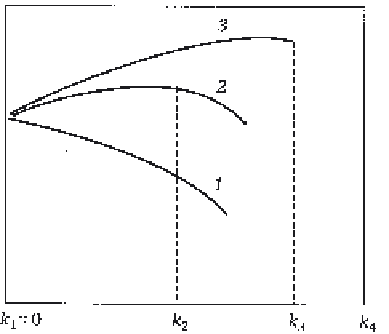Environmental Engineering Reference
In-Depth Information
by ten or more times. Introduction of economically optimum standards of
defects to operating nuclear power plants reduces the labour content and
exposure doses ten times while improving their safety (due to reduced
maintenance, additional analysis of strength and operating life and resources
and the use of freed-up resources to increase safety during operation).
7.4.3 Cost-optimum time interval between inspections
(deterministic approach)
The time interval between inspections (or frequency of inspection) affects
the economic factors.
Figure 7.16
106
shows the dependence of the income earned in the
operation of structures (e.g. NPP) on the frequency of inspection for the
entire period
k
.
Curve 1 corresponds to the case when inspection of the element of the
structure (or the entire object) is economically not advantageous, i.e. losses
from its unreliable operation are small and do not exceed the cost of
inspection, and the optimum frequency of inspection
k
1
is then equal to 0.
Curve 2 corresponds to the case when the income from operation in
inspection at a low frequency increases but the inspection volumes increase
dramatically and the total revenue from operation begins to fall. The
maximum point on curve 2 corresponds to the economically optimum
inspection frequency.
Curve 3 corresponds to the constructions whose failures have catastrophic
consequences and are unacceptable for society. Any inspection costs in this
case are much smaller than the losses due to the accident. The optimum
inspection frequency
k
3
at which the 100% reliability of the structure is
reached (100% reliability can be unattainable and it can be replaced by
another that is acceptable).
Inspection frequency
7. 1 6
Determination of optimum inspection frequency.

Search WWH ::

Custom Search